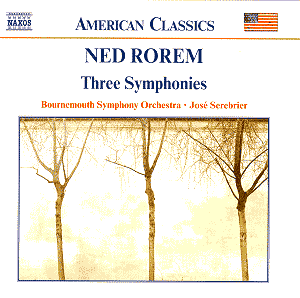I used to be of the opinion that Ned Roremís
music was not particularly interesting and somewhat contrived.
Of course, I appreciated his fame as a composer of songs, but
more for the fact that he actually kept the art song alive. Indeed
he gave it a new lease on life and encouraged other composers
to contribute to the literature. As for my above stated opinion,
well, I was dead wrong. Rorem is a master of the orchestra, and
these three symphonies are not only welcome, but long overdue
additions to the recorded repertoire of American orchestral music.
All composed in the 1950s, these works have lain
dormant for decades, with two of them only now receiving their
first recordings. Hats are off to José Serebrier for his
championing of this beautifully scored music. There is certainly
a resemblance to the other great orchestral composers of his generation.
Barber and Diamond come to mind as one listens to the opening
passacaglia of the third symphony. The gorgeous largo of the same
symphony is as atmospheric as anything I have ever experienced.
The woodwind writing in the first symphonyís largo is to die for.
But although Rorem clearly belongs to his generation, his is a
voice all his own, and what a crime that more of his large output
of orchestral music is not standard fare. He certainly is a craftsman
of the first order, truly a master composer.
These are tuneful and lush works, and although
traditional in concept, they are certainly fresh. Rorem proves
beyond doubt that it was and is possible to compose original music
that is devoid of the kind of scraping and noise-making typical
of the academic composers of the middle twentieth century. I was
struck by the fact that I immediately knew that this was music
to which I would want to return later. I often hear new (and these
must be considered new given their unacceptably scarce performances)
works that might leave somewhat of a good impression, but do not
entice me to bother with a second listen.
Serebrier and his Bournemouth players are above
reproach. The string sound is rich, but it is also taut and lean
where Roremís close harmonies dictate flawless intonation. The
orchestra plays with superb ensemble and intonation, and Serebrier
has a fantastic sense of line and forward motion. Nothing ever
stagnates here; rather we are pulled along by his keen excitement
and obvious appreciation for this music. It is evident just from
the way these musicians launch into the scores that they have
a great respect and appreciation for it.
Sound quality and production values are superb,
and the excellent notes by the conductor, with contributions from
the composer himself greatly enhance an already outstanding performance.
Naxos have done miracles for American music with this fine series
of recordings. One can only imagine what else they might have
in store. One can also certainly hope that this excellent performance
will encourage other conductors to program this music, which has
languished in obscurity for far too long. Add this to your collection
immediately if not sooner.
Kevin Sutton
see also review by John
Quinn, Rob
Barnett and Paul
Shoemaker
